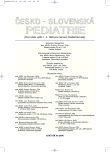Long-term Observation of Functional Structural Changes in Children with Vesicoureteric Reflux
Authors:
T. Baltesová 1; Ľ. Podracká 1; E. Sádová 1; K. Trejbalová 1; Z. Kurcinová 2; J. Takács 3; M. Verebová 4
Authors‘ workplace:
I. Klinika detí a dorastu LF UPJŠ a DFN, Košice
prednostka prof. MUDr. Ľ. Podracká, CSc.
1; Urologická klinika, Fakultná nemocnica L. Pasteura, Košice
prednosta doc. MUDr. L. Valanský, CSc.
2; Inštitút nukleárnej a molekulárnej medicíny, Košice
riaditeľ MUDr. I. Marin
3; I. Klinika rádiológie a zobrazovacích metód, Fakultná nemocnica L. Pasteura, Košice
prednosta MUDr. P. Mach, CSc.
4
Published in:
Čes-slov Pediat 2006; 61 (10): 566-572.
Category:
Original Papers
Overview
Aim:
To evaluate glomerular filtration rate (GFR) and structural changes in children with primary vesicoureteric reflux (VUR) in relation to the duration of follow-up period.
Patients and methods:
GFR was calculated according to Schwartz formula in 53 patients (20 boys), mean age 9.5 ± 5.7 yr. with grade III. to V. VUR (28 bilateral). The change in GFR (ΔGFR) was expressed as percentage of baseline GFR. Kidney size was determined by ultrasonography and renal scars were detected by DMSA scan. 27 patients were treated surgically, 15 were managed conservatively a 11 received combined treatment (surgery and antimicrobial prophylaxis).
Results:
2-year follow-up was completed in 53 patients, 5-year in 41 and 10-year outcomes were available in 15 patients. GFR was below physiological range in 2 children at the time of diagnosis, at 2 years GFR decreased in 5 patients (9.4%). The decline of GFR was present in 18 children (43.9%) after 5 years and in 9 (60%) after 10 years of follow-up with mean ΔGFR -12.2% and -18.1%. GFR <80 ml/min/1.73 m2 was noticed in 6 children at 5 yr. evaluation, 2 children (3.7%) reached end stage renal disease during study period. Kidney growth failure was found in 36 patients. Interestingly, one shrunken kidney was detected in 17 children with bilateral reflux. 10 of those children (58.8%) had repeated pyelonephritides, 3 (17.6%) had persisting reflux. DMSA proved scars and side difference in 26 children at the time of diagnosis, progressive scarring occured in 21 children (11 segmental changes, 10 worsening of side difference).
Conclusion:
Negative functional changes of kidneys are related to the time of follow-up. Structural changes of renal parenchyma depend on initial parenchymal injury and frequency of acute pyelonephritis.
Key words:
vesicoureteric reflux, renal functions, children
Labels
Neonatology Paediatrics General practitioner for children and adolescentsArticle was published in
Czech-Slovak Pediatrics

2006 Issue 10
Most read in this issue
- Diabetic Ketoacidosis
- The First Case of Glucose Transporter Type 1 (GLUT-1) Deficiency Syndrome in Slovakia
- Therapy of Diabetic Ketoacidosis
- Familial Hypomagnesemia with Hypercalciuria and Nephrocalcinosis – Cases and Differential Diagnosis
